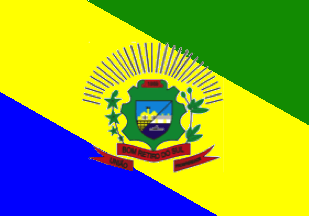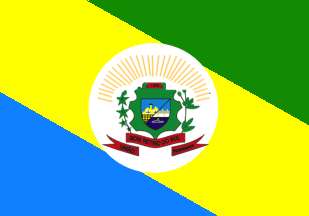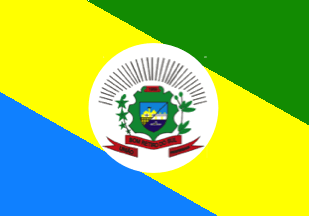 image by Ivan Sache,
12
July 2020
image by Ivan Sache,
12
July 2020 
Last modified: 2020-07-13 by ian macdonald
Keywords: rio grande do sul | bom retiro do sul |
Links: FOTW homepage |
search |
disclaimer and copyright |
write us |
mirrors
 image by Ivan Sache,
12
July 2020
image by Ivan Sache,
12
July 2020
The municipality of Bom Retiro do Sul (12,158 inhabitants in 2016; 10,233 ha)
is located 100 km of north-west of Porto Alegre.
Bom Retiro do Sul was
allegedly named for a hill that constitutes a convenient retreat ("retiro") to
gather cattle and supply them with salt. Other say that the name of the
municipality was coined as a tribute to Luiz Pereira de Couto Ferraz, Viscount
of Bom Retiro, Minister of the Brazilian Empire (d. 1886). On 1 January 1945, in
compliance with the law that prohibited the use of the same name for different
entities, the municipality was renamed to Ilhandava, for a native word meaning
"running water". The Municipal Councillor Álvaro Haubert pushed the restoration
of the original name, with the addition of "do Sul" for the sake of
differentiation, which was obtained by Municipal Law No. 59 promulgated on 28
April 1949.
Bom Retiro was established on 15 March 1887 when Jacob Arndt
acquired a domain from Adolfo Ribeiro. Antônio Israel Ribeiro, Henrique and
Jacob Arnt, and Jorge Fett subsequently acquired more plots from the same
landowner.
Bom Retiro do Sul was elevated to the 2nd district of Taquari by
Act No. 11 issued on 5 December 1895.
Bom Retiro do Sul boomed due to
commercial navigation on river Taquari. The first commercial building created in
the town was a warehouse used to store products from Upper Taquari that were
subsequently shipped to Porto Alegre via the river. The Arndt Navigation
Company, established in the beginning of he 20th century, operated in 1914 the
first passenger steamer on river Taquari. In the 1920-1940s, the company
operated five steamers, nine gasoline-powered ships, ten barges and another 3O
smaller boats. The luxury steamers "Itália", "Osvaldo Aranha" and "Porto Alegre"
served a scheduled line between Taquari and Porto Alegre. There were two other
navigation companies in Bom Retiro do Sul, Faller, which operated two powerful
gasoline-powered ships, the 'Teutônia" and the "Serteia", and Liberdade, owned
by Pedro Isírio. Additionally, minor companies and private boats, such as the
gasoline-powered "Fandango", owned by the Jasper family, contributed to river
traffic. The last company in operation was Nitzk & Görgen, owner of the
passenger gasoline-powered "Taquari" and of a floating warehouse.
Navigation
resumed decades later after the inauguration of the barrage of Bom Retiro do Sul
in 1977. This made Taquari navigable on 432 km from the port of Rio Grande.
https://bomretirodosul.rs.gov.br/
Municipal website
Ivan Sache,
12
July 2020
Divided per bend, green-yellow-blue, with the municipal arms centred on a white oval disk.
Official website is at http://www.bomretirodosul.rs.gov.br.
Dirk Schönberger,
6 January 2012
The flag and arms of Bom Retiro do Sul are prescribed by Municipal Law No.
549 promulgated on 17 May 1979.
Article 1.
The coat of arms of Retiro
do Sul has the following characteristics:
a) on one side, cassava, on the
other, soybean, as the main crops;
b) a factory - representing ever growing
industry;
c) a boat - representing the Bom Retiro do Sul barrage and
uttermost important river Taquari;
d) 1959 - the year of political
emancipation;
e) sun rays - as a symbol of progress;
f) the writing "Bom
Retiro do Sul - União e Prosperidade", emphasizing union that should exist in
the community.
Article 2.
The flag is composed of three parts.
Green, yellow and blue, green and blue forming two right-angled triangles and
yellow a quadrilateral ascending between the triangles, the right angle of the
green triangle in the flag's upper right and the right angle of the blue
triangle in the flag's lower left. Charged in the center with the coat of arms
described above. The colors of the flag have the following meaning: blue recalls
the sky and river Taquari, green represents the fields and agriculture, and
yellow represents the wealth Bom Progresso will obtain by continuing its
development.
https://leismunicipais.com.br/a/rs/b/bom-retiro-do-sul/lei-ordinaria/1979/55/549/lei-ordinaria-n-549-1979-adota-oficialmente-o-brasao-e-a-bandeira-do-municipio?q=bandeira
Leis Municipais database
The flag is used, at least, in three
versions
- with the arms directly applied to the field (shown above)
Photos
https://www.facebook.com/municipiodebomretirodosul/
https://www.facebook.com/municipiodebomretirodosul/
https://www.facebook.com/municipiodebomretirodosul/
https://www.facebook.com/municipiodebomretirodosul/
- with the arms, with yellow rays, inscribed in a white disc
 image by Ivan Sache,
12
July 2020
image by Ivan Sache,
12
July 2020
Photos
https://www.facebook.com/municipiodebomretirodosul/
https://www.facebook.com/municipiodebomretirodosul/
https://www.facebook.com/municipiodebomretirodosul/
https://www.facebook.com/municipiodebomretirodosul/
- with the arms, with black rays, inscribed in a
white disc
 image by Ivan Sache,
12
July 2020
image by Ivan Sache,
12
July 2020
Photos
https://www.facebook.com/municipiodebomretirodosul/
http://www.jornalng.com.br/news/desfile-civico-da-patria-acontece-dia-7-de-setembro-em-bom-retiro-do-sul
Ivan Sache, 12 July 2020